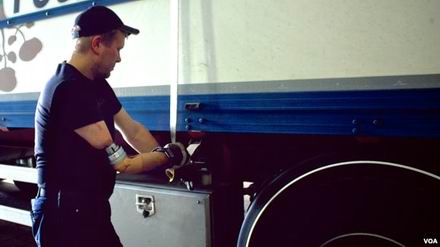
|
|

|
|
| April 25, 2024 |
|
Scientists create mind-controlled prosthetics 
Life-like artificial limbs are on the way
Two independent teams of researchers have developed prosthetic devices that behave and feel sensation just like real arms and hands. One device, implanted into the remaining bone, gives amputees a full range of movement using electrical impulses from the brain. The other invention restores the sense of touch. Artificial hands that look real have been on the market for some time. Now, researchers are creating prosthetic devices that have the sense of touch and exhibit a full range of motion like the missing appendage. One prosthetic, an artificial arm developed by Swedish researchers, is attached to the remaining bone within the amputated limb of the wearer. Electrodes implanted under the skin receive motor impulses and translate them into movement. Biomedical engineer Max Ortiz Catalan of Chalmers University of Technology in Gothenburg, Sweden, helped develop the life-like artificial arm. “Some of those muscles are still there. The nerve cells [are] still there," said Catalan. "So we can pick up those signals coming down from the brain and use them to tell the prosthesis what to do.” Mind control Catalan and co-researchers describe the mind-controlled artificial arm implanted in a male patient, a truck driver who lost his arm a decade ago, in Science Translational Medicine. Before the implant, the man controlled the prosthesis, imperfectly, through electrodes placed on his skin. But now, Catalan said, the man has complete, stable movement and use of the arm. “The patient is using it on his in activities of ... daily living, and playing with his kids, and doing stuff at his home and working. So, he went from working from 50 percent to working 100 percent and he can wear the prosthesis all day.” Catalan says researchers plan to start implanting the device in patients with amputated arms beginning next year. Now, imagine an artificial hand that actually feels sensation. Feeling sensation In a second paper in the journal, Dustin Tyler and colleagues at Case Western Reserve University in Cleveland, Ohio, describe how they used implanted electrodes to stimulate sensation in an entire prosthetic limb. “They have an artificial hand, but what they feel is as though it is their hand. And so we are applying electrical stimulation techniques directly to the nerves that used to go to the sensors in the real hand. And so by activating those, their perception is that it is their real hand,” he said. The experimental device that creates sensation in a prosthetic hand sits in a box on a desk in the laboratory, much to the disappointment of the two men who have been part of the experiment for some two years. “You know, one of our subjects basically said when he leaves he has to leave his hand behind because he can not have the sensation outside of the lab," Tyler said. "So, the feeling of their hand back is so powerful, they would like to have this [feeling] continually.” Tyler said the goal now is to make the device portable by implanting a controller, possibly in the chest. He said it would be possible to integrate the technology into the mind-controlled prosthetic arm developed by Swedish researchers to make the artificial hand even more like a real one. (Source: voanews.com) Story Date: October 13, 2014
|